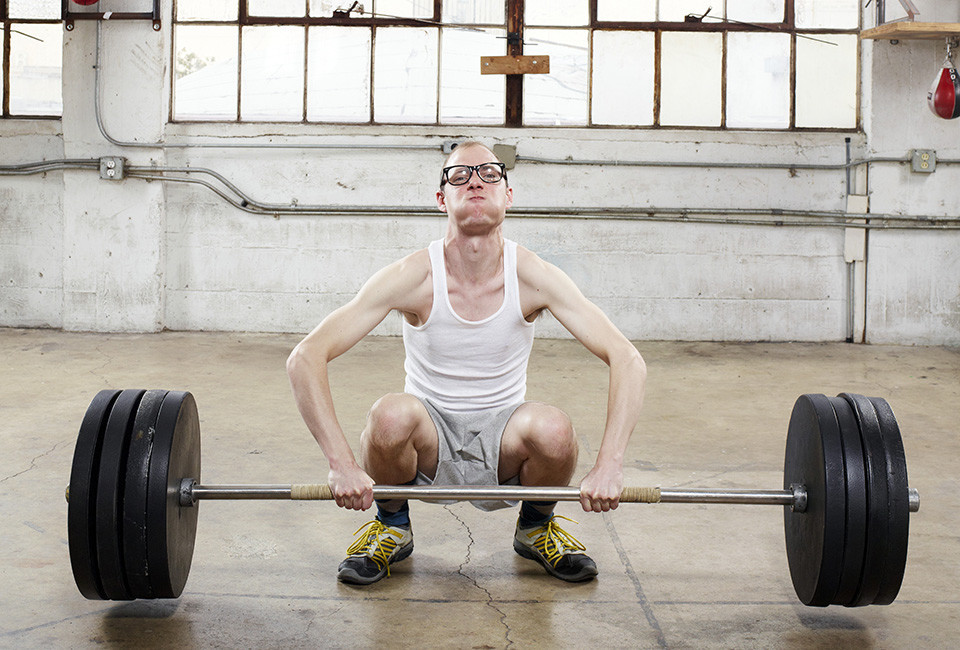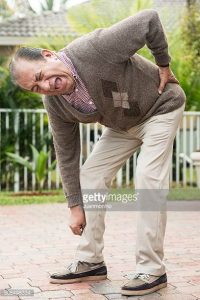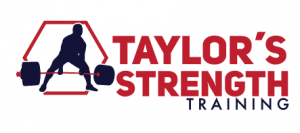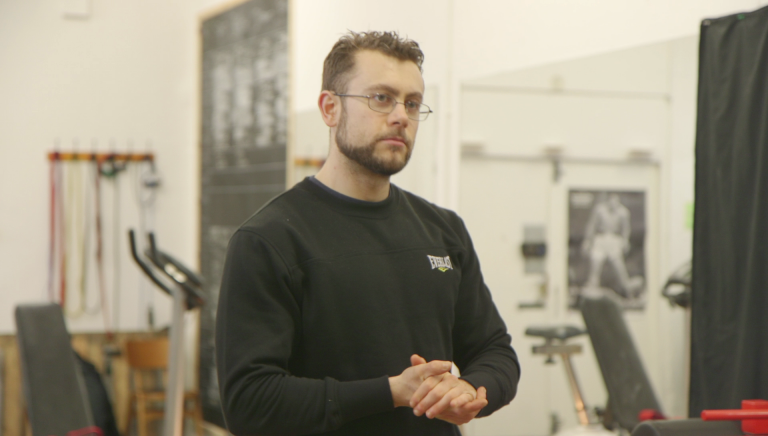My Personal Journey to Powerlifting

Setting The Stage
Having been ‘training’, ‘working out’, lifting weights – whatever you want to call it for 19 years now I’ve had a go at pretty much everything. Except Crossfit.
I’ve made friends, some enemies, injured every part of my body at least once, and been in some amazing gyms (for different reasons) around the world.
I’ve always been into sport, and fairly good at it. Swimming was my main sport for about 15 years, it keeps you very fit, works your aerobic and anaerobic systems and uses every muscle in your body – there’s really nothing like it. I also played/competed in football, tennis and water-polo to a high level. I like to think that this solid base of sport and exercise gave me a strong foundation to compete through my life, and it certainly gave me the building blocks to get strong. If you compete when you’re young I also think that it sets you up mentally for those sort of situations in the future.
Some notable former swimmers include Richard Gozdecki (who I swam against) – former Natural Mr Universe and British Indoor Rowing Champion, and of course Eddie Hall – current World’s Strongest Man.
I’d grown up watching Worlds Strongest Man on TV with my dad, like I suspect a lot of people did. The size and strength of these men was unbelievable to me, and really did inspire me.
It’s interesting to me to hear how people have got to where they are, and why they have ended up in Powerlifting, so hopefully this will be of interest to some of you – and if not, I’ll be back to talking about moment arms and angles etc. very soon.
College – The Early Years
I haven’t been to college for a long time, obviously, so I’m not sure if this is the same now – back then every Wednesday afternoon we had to do some sort of physical activity for two hours. Some people played tennis, some people basketball, me and two/three friends went to the gym.
It was a small leisure centre gym in Middlesbrough and it wasn’t the best; a cable machine, some random resistance machines and two benches with dumbbells that went up to 30kg. No barbells. Being 16, we focussed on the important things – biceps curls and calf raises. Any sort of squatting or upper leg work was too painful so that got left out.
Back then I like to think that I was fairly strong comparted to other lads in general, but weaker than one of my training partners. I remember someone reversed a car outside the gym and ended up hanging over a large storm drain (back wheels over the edge and spinning). It was stuck. This lad went over, stood in the storm drain, picked up the back end of the car and rolled the car forward on it’s front wheels – back onto the road. He was the year below us, and could curl more than me too.
This regime of what was effectively messing around for two hours a week went on for two years, and by the time I left college I could chest press the 30kg dumbbells twice. Unfortunately, my calves still looked like pipe-cleaners. We left college and I took a couple of years out, found a new gym partner but did nothing consistent until I left for university.
University
Having moved to Liverpool and now living with four other lads, all on sports courses, it was easier getting into a consistent routine at the gym. I’d hit 12 stone (76.5kg) and was ready to get strong.
Spindles Gym at the Adelphi hotel; all sorts of people trained here, students, doormen, businessmen & some pretty good bodybuilders. Sure enough my flatmates and me joined within a couple of weeks of moving in and we hit the sauna and jacuzzi five or six times a week to sweat out the vodka & Redbull from the night before. Training was going well.
Bodybuilding had always interested me, as it does most young gym-going males. Bodybuilders and ‘Strongmen’ were the ultimate strength figures to aspire to. At this stage I picked up a barbell for the first time, and bench pressed 60kg for a very wobbly single, at age 20. Disgraceful.
After I had ‘trained’ with my friends for a while, I started training with a competitive bodybuilder who worked at the gym. This is where the proper work started. It’s also worth noting that up to now I had no idea about nutrition, water, recovery etc.
The drinking was still going strong, but I was getting up at midday so it evened it all out.
I was working all of this around a bar job which took up 50-60 hours a week, further reducing my recovery – and ruining any attempt at eating the right food.
I finally got into a routine; in the gym for 60-90 minutes five/six times a week and after a while I was eating better and eating a lot more – steaks, tuna, pasta, chicken, fish etc. The lads I lived with took the mick, but it was working. After two years I was now up to 13 stone (82.5kg) and looking reasonably good, or as good as you can do going out 6 nights a week. I was also noticing my strength going up, bodybuilding training isn’t conducive to max strength, and it didn’t bother me back then – but it was a nice side effect.
On this subject, I’ll also point out that the training was all about moving a fairly heavy weight as many times as possible – going to failure almost, if not every set. I wore lifting straps for everything. My grip has always been bad, and this didn’t help, but it didn’t matter. The training won’t have the effect it should if your grip gives out before your muscles, so the straps were essential. It wasn’t just deadlifts either – rows, lat pull-downs, even biceps curls (if these are done after a 90 minute session going to failure every set, believe me you can’t hold a conversation let alone a dumbbell).
It really was addictive, there’s a famous quote of Mr Schwarzenegger’s regarding this – I wouldn’t quite say it’s that good, but it’s a strange feeling, kind of masochistic.
Post Uni Life
When I finished university and realised that three years earlier I’d chosen the wrong course, I had to decide on a future career. I enrolled on a Personal Training course with the promise of making £40 per hour, £100k a year for the rest of my life. If anyone’s ever tried this career path you will know that it’s hard, very hard. The actual training people part of it isn’t, but you need to be a very skilled marketer to get the clients in the first place. I’ve got all the respect in the world for people who make a success of this.
So, after a couple of years of giving it a go at several different gyms I decided it wasn’t for me. Even though this was a bit of a blow, it had given me lots of information that I could use for my own training. I knew what the muscles were that I was using, I knew what they did, and how they worked, and I knew how to make best use of them. This sounds a bit weird, but beforehand I didn’t have a clue, I did the exercises without really knowing what was going on in my own body. This is especially useful in bodybuilding, where an in-depth knowledge of your body and how it works really helps visualise and ‘feel’ your reps.
I got a job at the gym I’d been training at, and was now working with my training partner. This was good and bad, it meant I could train as much as I wanted and it really turned into a lifestyle. It also meant that not much ‘work’ got done – especially with a pool table next to reception.
Anyway, my lifts and my physique started getting better. I was never going to be at true ‘bodybuilding’ standard but I was happy with where it was going – I entered a bodybuilding competition – NPA Heart of England 2008. If you have ever taken part in any sort of competition then you will know it’s a scary thing to get up in front of lots pf people, especially on your own. I was particularly nervous as I knew I wasn’t anywhere near as good or as prepared as the other competitors. It’s a bad sign when you get to the warm up room and take your top off and your friend/coach says “I though you had been dehydrating”, yeh…I have. Everyone else looked like skeletons with muscles glued on and I looked like they’d just pulled me out of the audience.
On that subject – if you’ve ever been to a powerlifting competition you will know how friendly and supportive everyone is, not bodybuilding. I don’t want to make a sweeping statement about the whole sport, but it’s qualitive, not quantitive. In a sport that’s based on peoples’ opinions they certainly make them known. Anyway, I was happy with last place – back to the drawing board.
Going back a bit, during all this my lifts had been slowly improving, and my numbers going up. By the time I was 23 I had done a 210kg squat (well above parallel), a 200kg bench (massively assisted) and a 220kg deadlift (with straps and a big hitch). I was starting to get interested in powerlifting without knowing it, I knew I liked lifting heavy but didn’t know anything about how to train properly or what would be involved in competition. It also brought up another major issue – I hadn’t done a legitimate, legal ‘powerlift’ in years, not heavy anyway. I’d never squatted below parallel, I wasn’t even sure if I could, I’d never paused a bench press and I’d never deadlifted without straps or hitching – not heavy anyway. Bench press was always my best lift but I had no idea what I could really lift as there was someone else’s hands on the bars every rep I did. I guessed about 180kg, but I now realise that it was likely much less. I always heard the word’s “It was all you” – apart from the 80kg you were lifting though, yeh?
Changing my training would mean dropping weight right down to baby levels, this is obviously the right thing to do but back then my pride wouldn’t let me, so I carried on as I was.
Stagnation & Injury
At this point, aged 26 I got a proper job and some adult responsibilities. My training stagnated and I just tried to stay at the same level rather than deteriorating. I would train for 30 minutes five times per week, and this worked in keeping me looking fairly good and being fairly strong.
I’d also been struggling with a back injury since I was 19 which flared up every 6 – 12 months. Still undiagnosed to this day, I have no idea what it is, all I know is that it stops me doing everything when it happens, even walking. It all started when I used to play tennis, the serving motion (jumping, twisting & landing) did something to aggravate and tighten the whole of my lower back.
There’s a well-known story that most people at Taylors Strength know, of when I went on holiday. My back had started to become tight the day before we flew out and I knew what was coming. Sure enough I woke up on the morning of the flight and couldn’t move. The only way I can describe the pain is that it feels like someone’s pushed a knife through my spine and every time I try and move this knife slices through something.
I got in the taxi somehow and made it to the airport but we were late (due to me taking 20 minutes putting my socks on), walking through the airport it was getting worse and worse before I had to stop. I was stood in the middle of Manchester airport unable to even turn my head and nearly crying in pain, if someone would have knocked into me I’d have fallen like a bowling pin. Smashing my face off the floor would have been less painful than trying to move my foot to balance myself.
My girlfriend at the time (now wife) had to go and find help. Help arrived with a wheelchair after about 5 minutes, people thought I was doing some sort of performance art, like the statue men you see on the high street. Somehow again I got into this wheelchair, and even more surprisingly I was allowed onto the flight – getting up the stairs and into a plane seat must have been amusing to onlookers though.
Usually these episodes last 4/5 days and then gradually improve, this time however it was the full week of the holiday, plus a week after we got home.
Every time this happens I have to take my training back to basics, and for a long time I thought it would stop me hitting big numbers, like a physical threshold I couldn’t get past. It always (or mostly) happened after I had got back up to my strongest. This would eventually be proven wrong, but I’ll go into that later on.
A Change of Direction
At age 32 it was time for a change of path. I have family (in-laws) in the USA so I got onto a Strength & Conditioning internship at my brother-in-law’s old high school in New York. This place was unbelievable, anyone who’s ever watched any sort of US college sport (basketball, [American] football, lacrosse etc. knows how seriously they take their sport over there. Well this was a precursor to that, the school was for 11-18 year olds, but the facilities were far better than any university I’ve seen – I suspect on a level with places like Loughborough or Bath.
There was a weights room, fully kitted out with Hammer Strength platforms, racks, cages, benches, machines, several full sets of bumper plates, dumbbells, power bars etc. There were also 6 tennis courts, 4 squash courts, a basketball court with spectator seating, Astroturf [American] football pitch, lacrosse pitch, baseball field, 400m running track and full size ice-rink with spectator seating. The ski hill/course was 10 minutes down the road however.
My job was simple – to make all the pupils at this school better at all of the sports that they compete in. Easy…
It meant learning a few things, the rules of the sports and how to ice skate were two main ones, as well as how to convince a load of American teenagers that you know what you’re doing even though I’d never even held a lacrosse stick before.
The way they approach exercise and sport over there is so far removed from the UK it was hard for me to grasp. I’ve always been into sport so I understood my desire for this sort of set up, but this is life for all school children – this school was not special by any means and in fact other schools that I’d visit whilst over there had even better set-ups.
It is compulsory for the kids to take part in at least an hour of physical activity per day, and they also have to be part of a team. This is why there are different levels of team – Varsity, Junior Varsity (JV) & Thirds. Thirds is for people who don’t really want to be there (or just aren’t very good), but have to do something, JV is where you are if you’re average to good, and Varsity is for the exceptional – these kids will likely go to college (University) on a sports scholarship.
They were also very strong, because they had all been lifting weights since age 11 they were oblivious to how strong they actually were. I was told to watch one of the Varsity footballers train one day – so I did. He was squatting 180-190kg for reps whilst telling the others what music he wanted on the gym sound system. I was hoping he was 24 and had been kept back several years, but no such luck – he was 17. Fair enough he also weighed 110kg but even still.
It was a boarding school so the pupils all lived on campus. I had to train after work when they had all gone home, I had to at least pretend I was stronger than them to save face. Even though I was doing this, sometimes one or two would wander in and I’d have to rack my one-rep max and say “I’ll finish my warm-up later”.
It was safe to say that this inspired me, I returned home knowing that I wanted to get as strong as possible in the three powerlifts.
Powerlifting
So, three months later I was back and now knew what I wanted to do, and having just been embarrassed by some school kids I joined JD gym in Liverpool city centre. There were a few reasons for this, it had lots of weights, two deadlift platforms but most importantly of all – it’s the one my wife wanted us to join.
I read up on how powerlifters trained and educated myself as much as I could. It helped that my wife was also interested (and strong), so I started training her. She is a separate story, but some of you know that she ended up holding all the 63kg Northwest records at the same time and came 9th at the British Championships.
I heard of a powerlifting course being held up in my neck of the woods (Middlesbrough) at the end of 2015, being ran by Fred McKensie, James McGill & Andrew Richardson. I booked onto this to increase my knowledge of the sport, and to improve my own training. This is if I could train properly…
Meanwhile, I was injured again.
June 2015 and I was back to not being able to walk, never mind lift a weight. It wasn’t as bad as some previous times but I still had to ask a stranger to lift off my wife’s 60kg bench press in the gym because I couldn’t move it. My weight dropped to 95kg (this was the first time I’d been under 15 stone in six years) and morale was low.
After exploring Olympic Weightlifting for a few weeks, and nearly breaking both wrists I started training for powerlifting properly. It was at this stage that I met Stephen Manuel. He was a PT at the gym and up until now I had no idea that he was a competitive powerlifter, I’d seen him around Liverpool for years (you couldn’t really miss him) but assumed he was a bodybuilder. I’d chat to him sometimes and get bits of advice and information off him when I could, like most people I didn’t feel ‘ready’ to compete, and I would have liked to be stronger but eventually on his recommendation I entered a competition in January 2016.
Novice Powerlifting Competition
Being a ‘novice’ aged 33 is strange, I was closer to being a Masters lifter. I was nervous but knew that I was going to take it easy, I’d also been to several competitions with the other half so knew what to expect. In the lead up to this competition I had only put on my first pair of knee sleeves a week previously which meant squats still felt a bit alien. I’d also still never paused a bench press over 130kg, which was what I was opening at that day. Deadlift was something I was ignoring until I had to think about it later in the day, hoping it didn’t really have to happen. I’d resigned myself to sumo due to my recurring back injuries.
I weighed in at a stealthy 114.something kg and gave my openers as 140kg, 130kg, 155kg.
The rest of the day is a bit of a blur, but I did manage to end up on 170kg, 150kg, 180kg for a 500kg total. Not too bad considering the relatively short time I’d been training the lifts properly for, my bench saved too much embarrassment though – as it has done most times since.
Taylors Strength
In August 2016 I left JD & Dedicated Fitness and joined Taylors Strength in Liverpool, and it was definitely the best decision I’ve made regarding my lifting and training. Not only have my lifts all increased massively, as of yet, my back injury has kept away. I probably shouldn’t have typed that….
Having competed in several competitions since, I won the -120kg Northwest bench press with 160kg which qualified me for my first national competition, the British Bench Press. Danny (Taylor) came with me over to Horncastle to mentor me through this one, I was in with some very strong lads – I’d looked up the previous years results and saw that it had been won with 185kg. The person who had won had also entered this year, I was hoping he hadn’t got any stronger. Unfortunately he had, as had everyone else. Looking at the entries I was hoping for 6th until I heard someone had dropped out, maybe top 5 was possible? Fortunately (or unfortunately – however you look at it), a couple more people didn’t show up meaning there were just four of us left.
We gave my opener as 157.5kg which was easy, then 165kg and finishing on a grinder 167.5kg. I was very happy with this – a PB after a rocky build up. Without checking results I think 1st
& 2nd got 200kg (separated on bodyweight) and third was around 190kg. still, 4th is 4th.
I got a certificate, but British Powerlifting being what it (sometimes) is, my name was spelt wrong. I vowed to go back another and win another one with my actual name on it.
Most recently I have competed at the Northwest Championships in September 2017, finishing with 227.5kg, 170kg, 222.5kg for a 620kg total. I just missed out on the British qualifying total 625kg, but this is now my aim for this year.
I would advise everyone who is wanting to get into powerlifting, casual or competitive, or just getting stronger in general to give Taylors Strength in Liverpool a visit. There are no egos in here and everyone is genuinely friendly and helpful – as well as being the original powerlifting gym in Liverpool, and the first established powerlifting gym in the city.
As far as future goals go, I’m hoping to keep on getting better and stay injury free. I’m in it for the long haul – I’ve got my eye on the Masters 6 records (hoping that everyone else has given up by that stage). I may even give equipped lifting a go – watch this space.



